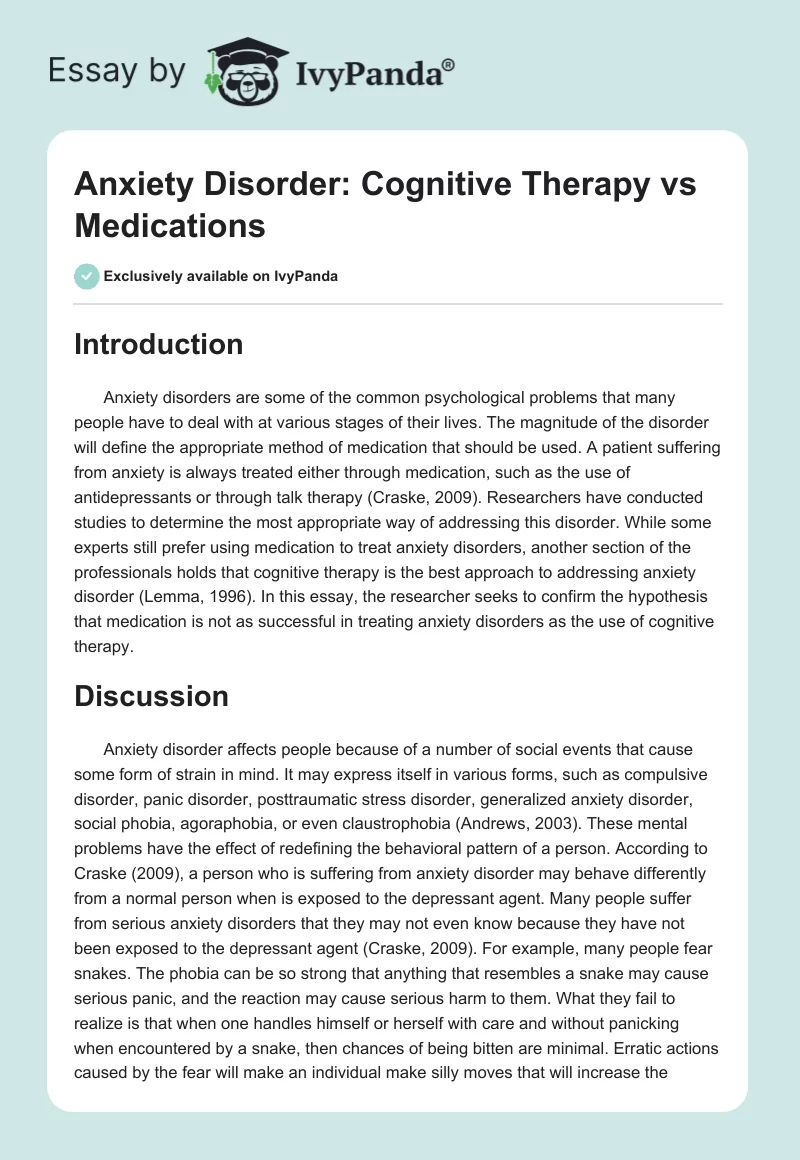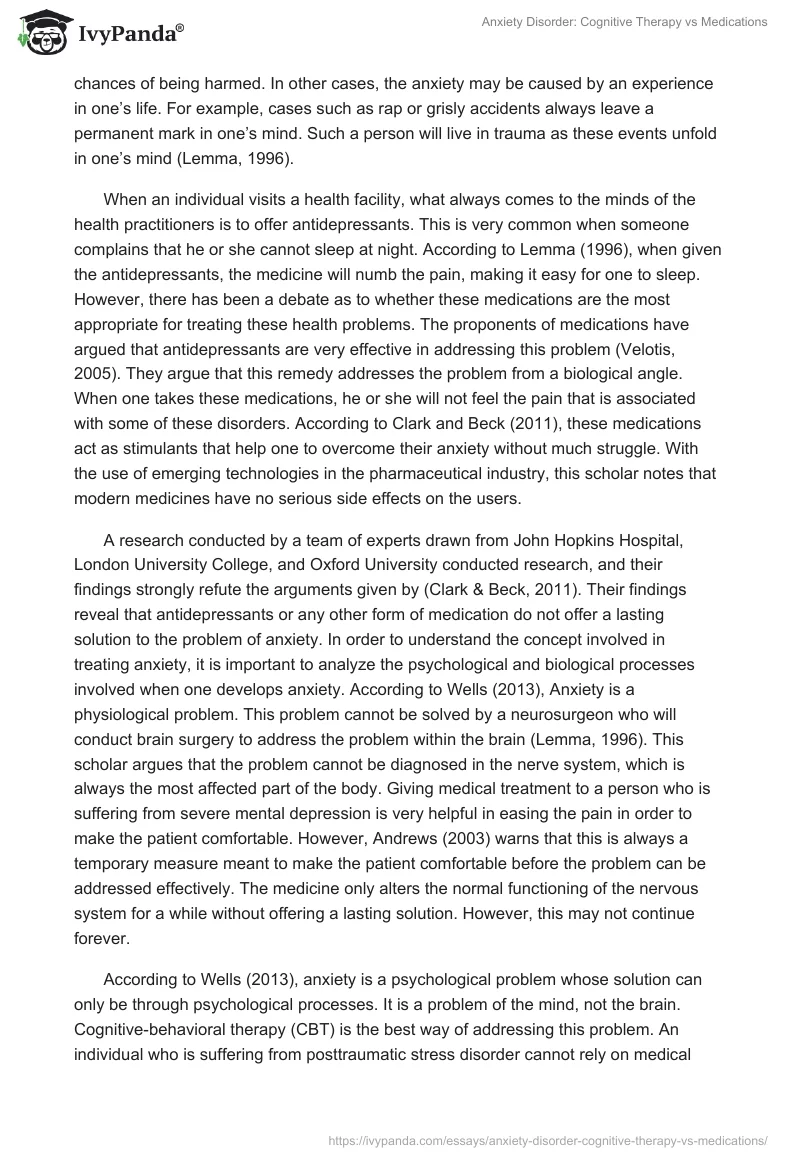Introduction
Anxiety disorders are some of the common psychological problems that many people have to deal with in their lives. The magnitude of the disorder will define the appropriate method of medication. A patient suffering from anxiety is always treated either through medication, such as the use of antidepressants, or through talk therapy (Craske, 2009).
Researchers have conducted studies to determine the most appropriate way of addressing this disorder. While some experts still prefer using medication to treat anxiety disorders, another section of the professionals holds that cognitive therapy is the best approach to addressing anxiety disorder (Lemma, 1996). In this essay, the researcher seeks to confirm the hypothesis that medication is not as successful in treating anxiety disorders as the use of cognitive therapy.
Discussion
Anxiety disorder affects people because of a number of social events that cause some form of strain in mind. It may express itself in various forms, such as compulsive disorder, panic disorder, posttraumatic stress disorder, generalized anxiety disorder, social phobia, agoraphobia, or even claustrophobia (Andrews, 2003). These mental problems have the effect of redefining the behavioral pattern of a person.
According to Craske (2009), a person who is suffering from anxiety disorder may behave differently from a normal person when is exposed to the depressant agent. Many people suffer from serious anxiety disorders that they may not even know because they have not been exposed to the depressant agent (Craske, 2009). For example, many people fear snakes. The phobia can be so strong that anything that resembles a snake may cause serious panic, and the reaction may cause serious harm to them.
What they fail to realize is that when one handles himself or herself with care and without panicking when encountered by a snake, then chances of being bitten are minimal. Erratic actions caused by the fear will make an individual make silly moves that will increase the chances of being harmed. In other cases, the anxiety may be caused by an experience in one’s life. For example, cases such as rap or grisly accidents always leave a permanent mark in one’s mind. Such a person will live in trauma as these events unfold in one’s mind (Lemma, 1996).
When an individual visits a health facility, what always comes to the minds of the health practitioners is to offer antidepressants. This is very common when someone complains that he or she cannot sleep at night. According to Lemma (1996), when given the antidepressants, the medicine will numb the pain, making it easy for one to sleep. However, there has been a debate as to whether these medications are the most appropriate for treating these health problems. The proponents of medications have argued that antidepressants are very effective in addressing this problem (Velotis, 2005). They argue that this remedy addresses the problem from a biological angle.
When one takes these medications, he or she will not feel the pain that is associated with some of these disorders. According to Clark and Beck (2011), these medications act as stimulants that help one to overcome their anxiety without much struggle. With the use of emerging technologies in the pharmaceutical industry, this scholar notes that modern medicines have no serious side effects on the users.
A research conducted by a team of experts drawn from John Hopkins Hospital, London University College, and Oxford University conducted research, and their findings strongly refute the arguments given by (Clark & Beck, 2011). Their findings reveal that antidepressants or any other form of medication do not offer a lasting solution to the problem of anxiety. In order to understand the concept involved in treating anxiety, it is important to analyze the psychological and biological processes involved when one develops anxiety.
According to Wells (2013), Anxiety is a physiological problem. This problem cannot be solved by a neurosurgeon who will conduct brain surgery to address the problem within the brain (Lemma, 1996). This scholar argues that the problem cannot be diagnosed in the nerve system, which is always the most affected part of the body. Giving medical treatment to a person who is suffering from severe mental depression is very helpful in easing the pain in order to make the patient comfortable.
However, Andrews (2003) warns that this is always a temporary measure meant to make the patient comfortable before the problem can be addressed effectively. The medicine only alters the normal functioning of the nervous system for a while without offering a lasting solution. However, this may not continue forever.
According to Wells (2013), anxiety is a psychological problem whose solution can only be through psychological processes. It is a problem of the mind, not the brain. Cognitive-behavioral therapy (CBT) is the best way of addressing this problem. An individual who is suffering from posttraumatic stress disorder cannot rely on medical solutions to address the problem permanently. For instance, a patient who is suffering from stress caused by a rape case will need CBT in order to overcome the problem. The person will need therapy that will help him or her learn how to live with the problem without feeling wasted.
According to Velotis (2005), the medicine that can make a person forget a painful life, experiences such as rape case does not exist. When a doctor is presented with such a case, there may be very little he or she can do to address the sad memory from a medical perspective. This is where a psychologist or a counselor comes in with a lasting solution.
A counselor will need to offer a therapeutic solution, which will involve getting into the root cause of the problem. He or she will allow the patient to narrate the whole ordeal with all the possible emotions. This is always the first part of the therapy. A patient always feels lighter after narrating the whole incident that caused the disorder.
After this has happened, the expert will need to engage the patient in a therapeutic discussion that will help the patient appreciate that the event was part of life that should make one stronger instead of feeling weak. This will eliminate the fear, panic, or stress that one had because of the occurrence of a given incident. It is only through such psychological processes that any anxiety disorder can be solved (Lemma, 2008).
Conclusion
The discussion above has confirmed the hypothesis that medication is not as good in addressing anxiety disorder as therapeutic processes. The discussion reveals that the antidepressants are good at easing the pain when one is suffering from these mental problems. However, it does not offer a lasting solution to the existing problem. It is only through cognitive therapy that one can get into the root cause of the problem and address it in an effective manner.
References
Andrews, G. (2003). The treatment of anxiety disorders: Clinician guides and patient manuals. Cambridge: Cambridge University Press.
Clark, D. A., & Beck, A. T. (2011). Cognitive therapy of anxiety disorders: Science and practice. New York: Guilford Press.
Craske, M. G. (2009). Anxiety disorders and their treatment. Boulder: Westview.
Lemma, A. (1996). Introduction to psychopathology. Thousand Oaks: Sage Publications Ltd.
Velotis, C. M. (2005). Anxiety disorder research. New York: Nova Science.
Wells, A. (2013). Cognitive therapy of anxiety disorders: A practice manual and conceptual guide. Hoboken: Wiley.


